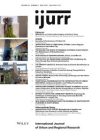Since the late 1970s, Atlantic Fordism has seen rising homelessness and ghettoization as the ‘new urban poverty’ (NUP) (Mingione, 1996). Despite some similarities, the NUP in Japan has a unique rhythm and spatial pattern. In order to explore Japanese NUP, this article develops an interpretation of Japan’s strategies to regulate poverty and homelessness during the last 50 years, paying particular attention to the spatial consequences of such strategies within major Japanese cities. First, I theorize long‐term economic growth patterns as a basic parameter of poverty and homelessness regulation and present a periodization of Japanese trends since the 1950s. Second, I analyze poverty in Japan and the transformation of national strategies of spatial regulation in the 1990s, when homelessness grew. Third, I examine the multi‐scalar processes through which new regulatory spaces of homelessness were produced in the 1990s and 2000s, when failures of post‐bubble crisis management ballooned in Japan. I argue that, through a dialectic between national/local rule‐setting and homelessness, the Japanese state fragmented the dominant scale of poverty regulation, rescaled the site of homeless regulation and contained homelessness in relatively autonomized cities. I conclude that, from the 1990s until the late 2000s, Japan’s homelessness and its contradictions tended to be transferred to the spheres of urban workfare and urban policing, which I call new regulatory spaces of homelessness, that lie around the fringes of national social rights.
Details
Written by:
Mahito Hayashi
Digital Object Identifier (DOI)
10.1111/j.1468-2427.2012.01200.x
About DOI
Read full article as PDF
Read full article as HTML
See the references for this article
